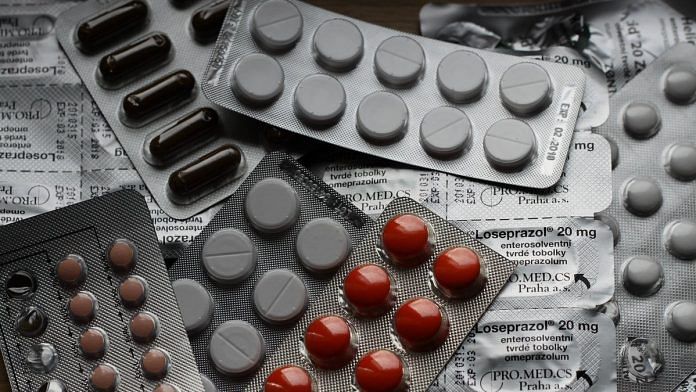New Delhi: The Narendra Modi government is planning to begin hunt for a “made in India” drug molecule, to demonstrate its drug discovery capabilities, ThePrint has learnt.
In a first-of-its-kind move, the government is planning to create a separate department for “research and development” with a focus on discovering new drug molecules that are “commercially viable”. It is also planning a separate post for the department’s head.
The Department of Pharmaceuticals (DoP), the apex authority under the parent Ministry of Chemicals and Fertilisers, is fine-tuning the proposal overseen by the Prime Minister’s Office (PMO), two government officials told ThePrint.
In its five-year vision document, the DoP had planned to “stimulate R&D in pharma” after the government came back to power for a second term in May.
“It will be the first time that India will have an official to head the R&D in the pharma industry. He or she will be responsible for stimulating the development of new drugs that are commercially viable,” a senior DoP official, who did not wish to be named, told ThePrint.
“Despite ample ongoing research projects in all the top institutes of India, we haven’t discovered any commercially viable drug molecules,” the officer added.
India remains out of the club of nations that have demonstrated the capability of developing a new drug molecule, despite being the third largest seller of medicines in the world — with 3,000 pharma companies and a network of over 10,500 manufacturing facilities.
Also read: India’s price control policy has destroyed drug manufacturers. This is how they can be saved
DoP plans
To boost drug discovery, the DoP in September had formed an inter-departmental committee to coordinate R&D activities undertaken by various top institutions such as the Indian Institutes of Technology (IITs), the National Institutes of Pharmaceutical Education and Research (NIPERs) and the Biotechnology Industry Research Assistance Council (BIRAC) among others.
Led by Pharma Secretary P.D. Vaghela and other joint secretaries in the department, the panel has now proposed to create a separate vacancy for the post of R&D head.
“Duties of R&D head are also being outlined. The committee is also studying the research gaps where all top research institutes such as IITs and NIPERs will be invited for consultations,” said a senior official in the Ministry of Chemicals and Fertilisers.
The committee is also proposing the plan to work on “creating industry-academia linkages”.
“For instance, if innovators at IIT have created a drug molecule, the government will help in finding pharma companies in launching the product in the market. Committee will also brief on clauses for revenue sharing between innovator and pharma firms.
“The objective of the committee is to guide innovators and industry to create commercially viable projects. DoP will extend help to these projects through its annual budgetary allocations,” said the official.
‘Government support must’
In 2012, India’s leading pharma player Ranbaxy had launched an anti-malarial drug, Synriam, which was touted to be the country’s first indigenously developed drug. However, the drug later failed to win that tag as none of its active ingredients were wholly developed in India.
“Innovation-led drug discovery research is capital intensive, research-intensive and intellectual property (IP)-intensive with inherently long gestational time lines for product commercialisation. The cost of new drug development is steep, with some estimates saying that it takes nearly a billion dollars and up to 12 years to take a new chemical entity (NCE) from lab to market,” said Kiran Mazumdar-Shaw, Biocon chairman and managing director.
“The situation is worsened by the absence of an enabling ecosystem wherein academia generates ideas, which are incubated to proof of concept through seed and incubation funding and then taken to market through business intervention backed by venture funding,” she said.
Biocon is credited with discovering two novel biologics for neck, head cancer and Psoriasis. Unlike traditional drugs, biologics are new age drugs which are produced from living organisms or contain parts of living organisms, such as tissues, genes and cells.
Mumbai-based drug maker Glenmark Pharmaceuticals echoed similar concerns. “India has a strong talent pool for research, inherent skills in chemistry and a vast manufacturing set up… Hence, government support for research in pharmaceutical space is critical,” said a company spokesperson.
Glenmark is also developing a new molecule, which is still under trials in US and Europe.
“While being considered the pharmacy of the world due to its (generics) drugs production capacity, not enough focus and policy action has been given to the area of R&D. This requires the country to invest in basic science, linkage with early stage studies, and have a sound clinical trial infrastructure, as well as facilities for ‘good manufacturing’ production,” said Anant Bhan, adjunct professor and researcher in bioethics at Mangaluru’s Yenepoya, a deemed university.
“Given the rising burden of disease, India will also need to look at its own health security needs in light of the current reliance on other countries such as China for raw materials,” added Bhan.
Also read: India’s price control policy has destroyed drug manufacturers. This is how they can be saved



